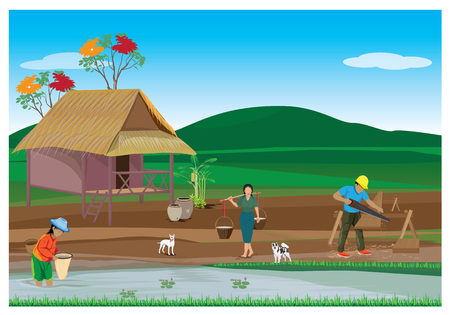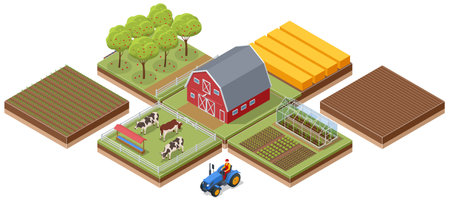Understanding Your Space
Before you start planting your dream backyard garden, its important to understand the space youre working with. Knowing your yard’s size, sunlight patterns, soil condition, and any microclimates will help you plan a layout that supports healthy growth and saves you time and effort down the road.
Measure Your Garden Area
Grab a measuring tape or use an online mapping tool to calculate the dimensions of your backyard. This will help you determine how much space you have for garden beds, walkways, seating areas, or even raised planters. Sketching out a rough map can be helpful too.
Common Backyard Sizes and What They Can Accommodate
| Backyard Size | Ideal Garden Features |
|---|---|
| Small (under 500 sq ft) | Container gardens, vertical planters, compact raised beds |
| Medium (500–1,000 sq ft) | Multiple raised beds, small greenhouse, herb spiral |
| Large (over 1,000 sq ft) | Full vegetable plots, fruit trees, compost area, outdoor kitchen |
Track Sunlight Exposure
Sunlight is one of the most important factors in gardening. Most vegetables and flowers need at least 6 hours of direct sunlight daily. Observe your yard throughout the day to identify sunny spots and shaded areas. You can also use a sun calculator app for more accuracy.
Sunlight Categories
| Light Level | Description | Best For |
|---|---|---|
| Full Sun | 6+ hours of direct sunlight | Tomatoes, peppers, sunflowers |
| Partial Sun/Part Shade | 3–6 hours of sunlight | Lettuce, spinach, herbs like parsley |
| Full Shade | Less than 3 hours of sun | Mosses, ferns, hostas |
Test Your Soil Type
Your soil’s texture affects drainage and nutrient availability. Grab a handful of moist soil and squeeze it in your hand:
- Sandy Soil: Falls apart easily; drains quickly but may lack nutrients.
- Clay Soil: Stays clumped; holds water well but can be dense.
- Loamy Soil: Holds shape loosely; ideal balance of drainage and nutrients.
You can also buy an affordable soil testing kit at a garden center or send samples to your local Cooperative Extension office for detailed analysis.
Identify Microclimates
A microclimate is a small area within your yard that has different conditions from the surrounding space. For example, a spot next to a brick wall might stay warmer due to heat reflection, while low-lying areas might collect water after rain. Identifying these zones helps you choose the right plants for each part of your garden.
Microclimate Examples:
- South-facing walls: Warmer—great for heat-loving plants like peppers.
- Trees or fences: Create shade—ideal for leafy greens or ferns.
- Dips in terrain: May collect water—best for moisture-loving plants.
The more familiar you are with your backyards unique traits, the easier it will be to create a productive and beautiful garden that thrives year-round.
2. Choosing What to Grow
Before you start digging or planting, it’s important to decide what you want to grow in your backyard garden. Picking the right mix of vegetables, herbs, flowers, and shrubs depends on your local climate, available space, sunlight, and how much time you can dedicate to gardening. This step is all about matching your gardening goals with realistic choices that thrive in your region.
Consider Your Growing Zone
The USDA Plant Hardiness Zone Map is a great starting point. It helps you figure out which plants are most likely to thrive based on your average annual minimum winter temperature. Look up your zone online and use it as a guide when selecting seeds or plants at your local garden center.
Know Your Garden Goals
Think about why youre building a garden in the first place. Are you hoping to grow fresh veggies for your kitchen? Want a fragrant herb patch near the patio? Or maybe youre after a low-maintenance flower bed that adds color and curb appeal? Here are some common goals and matching plant types:
| Goal | Recommended Plants |
|---|---|
| Fresh produce for cooking | Tomatoes, peppers, lettuce, cucumbers |
| Aromatic herbs for flavoring | Basil, rosemary, thyme, mint |
| Pollinator-friendly garden | Lavender, coneflowers, bee balm |
| Low-maintenance beauty | Drought-tolerant shrubs like boxwood or butterfly bush |
Selecting Plants That Fit Your Lifestyle
If you’re new to gardening or have a busy schedule, go for easy-to-grow plants that don’t need constant care. Think cherry tomatoes, zucchini, chives, and marigolds. If you love spending time in the garden and enjoy experimenting, try adding more challenging crops like eggplant or heirloom varieties.
Time Commitment Guide:
| Lifestyle Type | Suggested Plant Choices |
|---|---|
| Busy/Low Time | Lettuce, radishes, mint, sunflowers |
| Avid Gardener/More Time | Corn, pumpkins, rosemary topiary, roses |
Create a Mix That Works Together
A great backyard layout often includes a combination of edibles and ornamentals. Choose companion plants that support each other—for example, basil planted near tomatoes can enhance growth and flavor while helping keep pests away. Also consider height and spacing: tall plants like corn can provide partial shade for leafy greens during hot summers.

3. Designing the Layout
Now that youve chosen the perfect spot for your backyard garden, its time to design a layout that fits your space, lifestyle, and gardening goals. A well-planned layout not only looks great but also makes gardening more efficient and enjoyable. Let’s explore some popular and practical layout styles you can use to bring your backyard garden to life.
Raised Beds
Raised beds are one of the most popular choices for backyard gardeners in the U.S. They offer better soil control, improved drainage, and easier access—especially if bending over is a challenge. Raised beds can be made from wood, stone, or metal and are perfect for both vegetables and flowers.
Benefits of Raised Beds:
- Improved soil quality
- Better drainage
- Fewer weeds
- Easy to manage and maintain
Traditional Rows
This classic method involves planting in long, straight lines with walking paths in between. It works well for larger gardens or gardeners who plan to grow a lot of one type of crop. Its simple and effective but may require more space and water.
Best For:
- Large plots
- Root crops like carrots and potatoes
- Gardeners using mechanical tools or tillers
Square-Foot Gardening
If youre working with limited space or want to keep things organized, square-foot gardening is a smart choice. This method divides your garden into 1×1 foot squares, each planted with a different crop based on spacing needs.
Example Square-Foot Layout:
| Crop | Plants per Square Foot |
|---|---|
| Lettuce | 4–6 |
| Tomatoes | 1 |
| Carrots | 16 |
| Basil | 4 |
Companion Planting Techniques
This method focuses on placing plants together that benefit each other, either by improving growth, repelling pests, or enhancing flavor. For example, planting basil near tomatoes can improve the tomato’s flavor and help deter insects.
Popular Companion Plant Pairs:
| Main Crop | Companion Plant | Benefit |
|---|---|---|
| Tomatoes | Basil | Enhances flavor & repels pests |
| Cucumbers | Nasturtiums | Deter aphids & beetles |
| Cabbage | Dill | Attracts beneficial insects |
| Beans | Corn & Squash (Three Sisters) | Nutrient sharing & support structure |
No matter which style you choose—or if you decide to mix and match—designing your garden layout with purpose will help you get the most out of your backyard space. Think about what you want to grow, how much time you have for maintenance, and how you move around your garden space to make it work best for you.
4. Incorporating Practical Features
When planning your backyard garden layout, it’s important to think beyond just plants and flowers. Adding practical features can make your garden more functional, easier to maintain, and more enjoyable for everyday use. Let’s explore some key elements you should consider including in your design.
Pathways for Easy Access
Pathways not only enhance the look of your garden but also give you easy access to different areas without stepping on plants or muddy soil. Choose materials that match your style and budget—gravel, pavers, brick, or mulch are all great options.
| Material | Pros | Cons |
|---|---|---|
| Gravel | Affordable, easy to install | Can shift over time, needs borders |
| Pavers | Durable, neat appearance | More expensive, requires leveling |
| Brick | Classic look, long-lasting | Can be costly and labor-intensive |
| Mulch | Natural look, good for soil health | Needs regular replacement |
Irrigation Systems for Efficient Watering
An irrigation system helps keep your plants healthy while saving time and water. Whether you choose a simple soaker hose or a fully automated drip system depends on your garden size and budget.
- Soaker Hoses: Great for small gardens; lay them around plant bases for slow watering.
- Drip Irrigation: Perfect for larger or raised bed gardens; customizable and water-efficient.
- Sprinklers: Better for lawns than garden beds; may waste water if not properly adjusted.
Compost Areas to Recycle Organic Waste
A compost bin or pile is a smart addition to any backyard garden. It allows you to recycle kitchen scraps and yard waste into nutrient-rich compost that feeds your soil naturally. Place it in a convenient spot that gets some shade and has good airflow.
What You Can Compost:
- Fruit and vegetable scraps
- Coffee grounds and filters
- Lawn clippings and leaves
- Eggshells (crushed)
Avoid Composting:
- Dairy products and meat (they attract pests)
- Treated wood chips or sawdust
- Synthetic chemicals or pet waste
Fencing for Protection and Privacy
If you want to protect your plants from pets, deer, or other wildlife—or simply add privacy—a fence is a must-have feature. Depending on your needs, you can choose between decorative picket fences, wire mesh for veggie gardens, or taller wooden panels for full privacy.
| Fence Type | Main Purpose | Best For |
|---|---|---|
| Picket Fence | Aesthetic appeal, light protection | Cottage-style flower gardens |
| Wire Mesh Fence | Keeps out animals, inexpensive | Vegetable plots, small fruit trees |
| Tall Wooden Fence | Privacy and wind protection | Backyards near neighbors or roads |
By thoughtfully incorporating these practical features into your backyard garden layout, youll create a space thats beautiful, efficient, and enjoyable all season long.
5. Seasonal Planning and Crop Rotation
When it comes to backyard gardening, thinking ahead is key. Seasonal planning helps you make the most of your space throughout the year, while crop rotation keeps your soil healthy and productive over time. Let’s break down how you can plan for each season and rotate your crops effectively for long-term success.
Understanding Your Growing Seasons
The U.S. has a wide range of growing zones, so knowing your USDA Hardiness Zone is a great first step. This determines what plants grow best during specific times of the year in your area. Generally, there are four main gardening seasons:
| Season | Typical Planting Time | Common Crops |
|---|---|---|
| Spring | March – May | Lettuce, peas, carrots, radishes |
| Summer | May – July | Tomatoes, cucumbers, corn, peppers |
| Fall | August – October | Kale, broccoli, beets, turnips |
| Winter (in warmer zones) | November – February | Spinach, garlic, onions |
Planning Your Garden by Season
Create a seasonal planting calendar to help stay organized. Consider which crops thrive in cooler vs. warmer months and stagger your planting so you always have something growing. Succession planting—planting new crops as soon as one finishes—can maximize yields even in small spaces.
A Simple Seasonal Plan Example:
- Early Spring: Sow leafy greens like spinach and lettuce.
- Late Spring: Plant warm-weather crops like tomatoes and peppers.
- Midsummer: Start fall crops such as cabbage and carrots.
- Late Fall: Prep soil with compost; plant garlic or cover crops.
The Importance of Crop Rotation
Certain plants use up or add different nutrients to the soil. Rotating them each year prevents soil depletion and reduces pests and diseases that linger from season to season. It’s especially important if youre growing in raised beds or limited space.
A Basic 4-Year Crop Rotation Plan:
| Year | Main Crop Group |
|---|---|
| Year 1 | Leafy Greens (lettuce, spinach) |
| Year 2 | Fruiting Crops (tomatoes, peppers) |
| Year 3 | Root Crops (carrots, beets) |
| Year 4 | Legumes (beans, peas) |
This cycle helps restore nitrogen naturally and minimizes pest buildup. Be sure to group similar types together when rotating: leafy greens, fruiting veggies, root crops, and legumes all have different needs.
Tips for Long-Term Success
- Create a garden journal to track what you plant each season and where.
- Add organic matter like compost at least once a year to refresh your soil.
- If space is tight, rotate by container or raised bed instead of full plot.
A little seasonal planning goes a long way toward building a productive backyard garden that keeps getting better every year!


